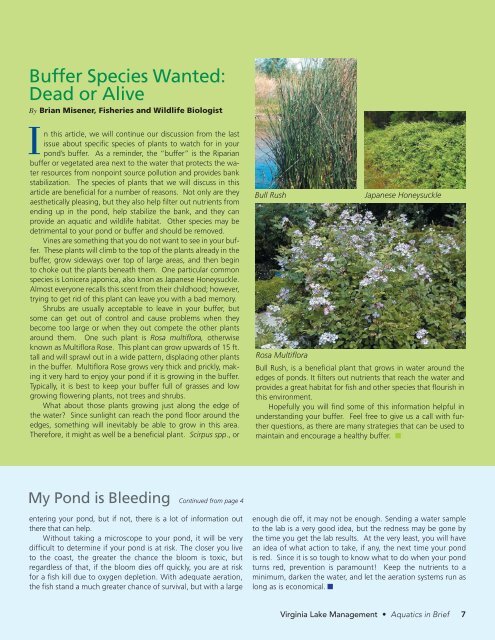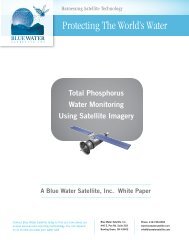<strong>Aquatics</strong>in<strong>Brief</strong> SPRING 2010 | Volume 4, Issue 2When Accuracy Matters: GPS <strong>Lake</strong> MappingGPS Bathymetric <strong>Lake</strong> Mapping by <strong>Virginia</strong> <strong>Lake</strong><strong>Management</strong> and The Mapping NetworkBy Tyler VanMeeteren, Director of Mapping Operations for The Mapping NetworkAlake or pond seems serene and effortless to maintain, butunder the surface is a dynamic organism requiring expertknowledge to produce a perfect balance. To fully enjoyyour lake or pond it is essential to know the facts for making thebest management decisions: exact acreage, depths, chemistry,etc. Armed with this knowledge you will be able to properly placestructure, deliver appropriate stocking densities, select the correctfish species, apply the right amount of weed control product, andof course gain a better idea where those bass may be hiding! Anaccurate GPS lake map provides the information needed to makethe most of your aquatic resource.A Nationwide Team of GPS and<strong>Lake</strong> <strong>Management</strong> ExpertsThe Mapping Network is a nationwide group of professionalsproviding the highest quality and most affordable bathymetric andasset mapping products on the market today. A local expert aquaticservice provider understands the dynamics of a lake to determinethe best transect paths to precisely model the lake’s bathymetry. TheFusing the latest technology trends in GIS andGPS mapping along with highly trained graphicalprofessionals, our bathymetric map of your bodyof water will be amazingly accurate and alsoaesthetically enjoyable.Mapping Network has partners located throughout the Countryworking directly with recreational property owners, lake associations,golf courses, marinas, developers, governmental organizations,and fishing clubs. <strong>Virginia</strong> <strong>Lake</strong> <strong>Management</strong> <strong>Company</strong> is thecertified <strong>Lake</strong> Mapping Partner in the region containing <strong>Virginia</strong>,North Carolina, Maryland, Delaware, and Pennsylvania. Fusing thelatest technology trends in GIS and GPS mapping along with highlytrained graphical professionals, our bathymetric map of your bodyof water will be amazingly accurate and also aesthetically enjoyable.On Site GPS Data CollectionMapping methods developed by The Mapping Network combinethe most accurate GPS mapping and Sonar technology. Our mappingsystem collects a 3-dimensional point every two seconds over anybody of water with sub-foot accurate location equipment and depthaccuracies of up to 1/10th of a foot. Once the data is collected in thefield it is processed with customized software programs to craft themost advanced bathymetric maps available today.Data Output OptionsContour Map: With unmatched detail, a contour map customcreatedby <strong>Virginia</strong> <strong>Lake</strong> <strong>Management</strong> <strong>Company</strong> and The MappingNetwork will provide you with the information needed to fullyunderstand volume and the characteristics of your lake or pond.3D Bathymetric Map: A 3D bathymetric map created using TheMapping Network technology provides the ability to easily visualizethe environment beneath the water line.Sedimentation Map: Sediment buildup in lakes and ponds isinevitable and the costs associated with removing this materialare extensive. Knowing where pockets of high sedimentationare located and the thickness of these deposits allows decisionmakersto make educated assessments and plan for the future.<strong>Lake</strong> maps created by <strong>Virginia</strong> <strong>Lake</strong> <strong>Management</strong> utilizing TheMapping Network technology provide managers/owners the abilityto more precisely locate problem areas, estimate sediment volumeand accumulation, and monitor sedimentation levels over a givenamount of time to determine if dredging is needed.Printing Options: Each map project is individually producedwith attention to detail and excellent customer service. Clients haveseveral options for the final map including hard copies, digital data,.PDF’s, and web applications for viewing. Our custom printed mapsrange from letter size to large format wall maps. We also provideseveral options for the final printing including standard paper,waterproof tough paper, glossy photo-based paper and lamination.No matter the mapping project, <strong>Virginia</strong> <strong>Lake</strong> <strong>Management</strong> andThe Mapping Network provide the expertise to provide you withthe final product best suited for your needs.Virtual Media: Utilizing unmatched detail, a virtual Swim-Through of your lake or pond created utilizing The Mapping Networktechnology will convey a new way of understanding your resource.These videos provide our clients an amazing 3D visualization oftheir asset - the ability to reveal this unseen, underwater world.The Time to Map is Now!<strong>Lake</strong>s can be mapped throughout the entire year. An accuratelake map provides the information needed to make the most ofyour aquatic resource. If you are serious about maintaining a highqualitylake or pond, be sure you have the ability to make the bestdecisions, get your lake mapped by the professionals with <strong>Virginia</strong><strong>Lake</strong> <strong>Management</strong> and The Mapping Network. ■6 <strong>Virginia</strong> <strong>Lake</strong> <strong>Management</strong> • <strong>Aquatics</strong> in <strong>Brief</strong>
Buffer Species Wanted:Dead or AliveBy Brian Misener, Fisheries and Wildlife Biologist<strong>In</strong> this article, we will continue our discussion from the lastissue about specific species of plants to watch for in yourpond’s buffer. As a reminder, the “buffer” is the Riparianbuffer or vegetated area next to the water that protects the waterresources from nonpoint source pollution and provides bankstabilization. The species of plants that we will discuss in thisarticle are beneficial for a number of reasons. Not only are theyaesthetically pleasing, but they also help filter out nutrients fromending up in the pond, help stabilize the bank, and they canprovide an aquatic and wildlife habitat. Other species may bedetrimental to your pond or buffer and should be removed.Vines are something that you do not want to see in your buffer.These plants will climb to the top of the plants already in thebuffer, grow sideways over top of large areas, and then beginto choke out the plants beneath them. One particular commonspecies is Lonicera japonica, also knon as Japanese Honeysuckle.Almost everyone recalls this scent from their childhood; however,trying to get rid of this plant can leave you with a bad memory.Shrubs are usually acceptable to leave in your buffer, butsome can get out of control and cause problems when theybecome too large or when they out compete the other plantsaround them. One such plant is Rosa multiflora, otherwiseknown as Multiflora Rose. This plant can grow upwards of 15 ft.tall and will sprawl out in a wide pattern, displacing other plantsin the buffer. Multiflora Rose grows very thick and prickly, makingit very hard to enjoy your pond if it is growing in the buffer.Typically, it is best to keep your buffer full of grasses and lowgrowing flowering plants, not trees and shrubs.What about those plants growing just along the edge ofthe water? Since sunlight can reach the pond floor around theedges, something will inevitably be able to grow in this area.Therefore, it might as well be a beneficial plant. Scirpus spp., orBull RushRosa MultifloraJapanese HoneysuckleBull Rush, is a beneficial plant that grows in water around theedges of ponds. It filters out nutrients that reach the water andprovides a great habitat for fish and other species that flourish inthis environment.Hopefully you will find some of this information helpful inunderstanding your buffer. Feel free to give us a call with furtherquestions, as there are many strategies that can be used tomaintain and encourage a healthy buffer. ■My Pond is Bleeding Continued from page 4entering your pond, but if not, there is a lot of information outthere that can help.Without taking a microscope to your pond, it will be verydifficult to determine if your pond is at risk. The closer you liveto the coast, the greater the chance the bloom is toxic, butregardless of that, if the bloom dies off quickly, you are at riskfor a fish kill due to oxygen depletion. With adequate aeration,the fish stand a much greater chance of survival, but with a largeenough die off, it may not be enough. Sending a water sampleto the lab is a very good idea, but the redness may be gone bythe time you get the lab results. At the very least, you will havean idea of what action to take, if any, the next time your pondis red. Since it is so tough to know what to do when your pondturns red, prevention is paramount! Keep the nutrients to aminimum, darken the water, and let the aeration systems run aslong as is economical. ■<strong>Virginia</strong> <strong>Lake</strong> <strong>Management</strong> • <strong>Aquatics</strong> in <strong>Brief</strong> 7





